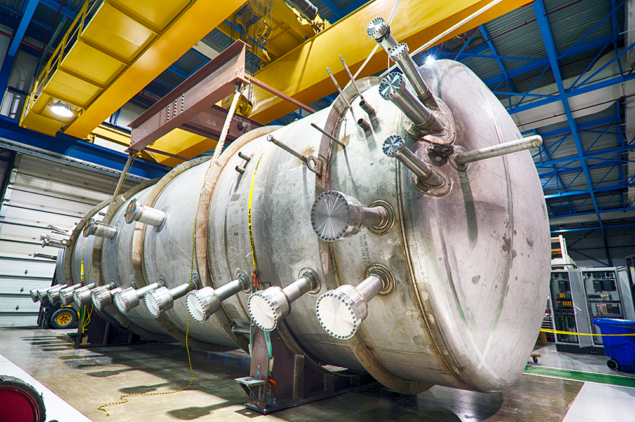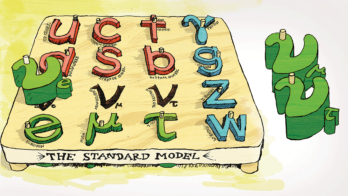
Excitement is building in the search for sterile neutrinos – long-predicted particles which would constitute physics beyond the Standard Model. Although impervious to the electromagnetic, weak and strong interactions, such a fourth “right-handed” neutrino flavour could reveal itself by altering the rate of standard-neutrino oscillations – tantalising hints of which were reported by Fermilab’s MiniBooNE experiment in 2007. In a preprint published last week, sibling experiment MicroBooNE strongly disfavours a mundane explanation for such hints, with further scrutiny by the collaboration expected to be announced later this month.
“If the MiniBooNE effect is indeed a sterile neutrino, this of course would be a major discovery which would revolutionise particle physics, opening up a whole new sector to explore,” says MicroBooNE co-spokesperson Justin Evans of the University of Manchester.
The story of the sterile neutrino began in the 1990s, when the LSND experiment at Los Alamos reported seeing 88±23 (3.8σ) more electron antineutrinos than expected in a beam of accelerator-generated muon antineutrinos. This apparent short-baseline oscillation from muon to electron antineutrinos was incompatible with the oscillation rates established by Super-Kamiokande in 1998 and SNO in 2002, and would have to occur via an unknown intermediate neutrino flavour with a mass of about an electron-Volt. This hypothesised neutrino was dubbed sterile, as it would have to be insensitive to all interactions but gravity for it to have remained undiscovered this long.
The photon hypothesis
The plot thickened in 2007 when the MiniBooNE experiment at Fermilab tried to reproduce the LSND anomaly. The team also saw an excess of electron-like signals, though not quite at the energy corresponding to the LSND effect. The significance of the MiniBooNE anomaly grew to 4.5σ by the time the experiment finished running in November 2018. But a mundane possible explanation poured cold water on hopes for new physics: as a mineral-oil Cherenkov detector, MiniBooNE could not differentiate electrons from photons, and one particularly tricky-to-model background process might be contributing more photons than expected.
Many of us suspected that there could be something wrong with predictions for this background
Joachim Kopp
“High-energy single photons can be produced when a neutrino scatters on a nucleon via a neutral-current interaction and excites the nucleon to a Δ(1232) resonance,” explains CERN theorist Joachim Kopp. “Most of the time, the resonance decays to a pion and a nucleon, but there is a rare decay mode to a nucleon and a photon. The rate for this mode is very hard to predict, and many of us suspected that there could be something wrong with predictions for this background.”
Enter MicroBooNE, a liquid-argon time-projection-chamber sibling experiment to MiniBooNE which is capable of studying neutrino interactions in photographic detail, and differentiating the two signals. Having detected its first neutrino interactions in 2015, the MicroBooNE team has now set a limit on the neutral-current Δ→Nγ process is more than a factor of 50 better than existing constraints, explains Evans. “With this MicroBooNE result, we reject a Δ→Nγ model of the low-energy excess at 94.8% confidence, a strong indication that we must look elsewhere for the source of the excess.”
The electron hypothesis
Now that MicroBooNE has strongly disfavoured a leading-photon model for the MiniBooNE anomaly, attention shifts to the electron hypothesis – which would hint at the existence of a sterile neutrino, or something more exotic, if proven. And we don’t have long to wait. The MicroBooNE collaboration plans to release its search for an electron-like low-energy excess on 27 October, with results from three independent analyses looking at a range of inclusive and exclusive channels.
Beyond that, there is more to come, says Evans. “Our current round of results use only the first half of the total MicroBooNE data-set, and this is a programme that is only just beginning, with ICARUS and SBND within Fermilab’s short-baseline programme now coming online to turn this into a multi-baseline exploration of the richness of neutrino physics with unparalleled detail.”
The global picture is complex. In 2019, for example, the MINOS+ experiment failed to confirm the MiniBooNE signal (CERN Courier March/April 2019 p7). Were the sterile neutrino to exist, it should also have significant cosmological consequences which remain unobserved. But the anomalies are accumulating, says Kopp.
“LSND and MiniBooNE are quite consistent, and the short-baseline reactor experiments require parameters in the same region of parameter space, though these results are very much in flux and it’s not clear which ones are trustworthy, so it’s hard to make precise statements. The good news is that there’s realistic hope of resolving these puzzles over the next few years. ”





